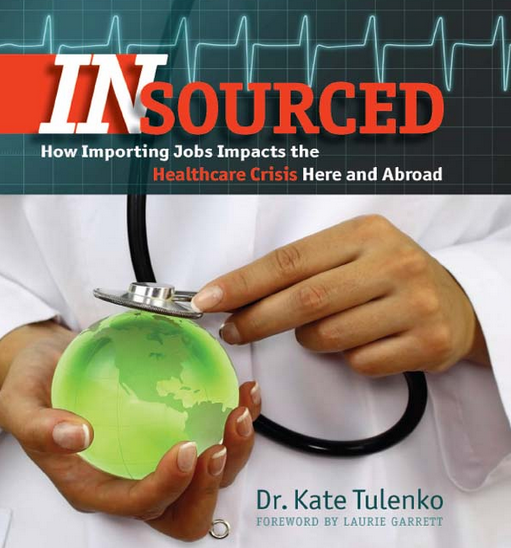A Lose-Lose Situation: How medical insourcing impacts developing and developed countries (Part 2)
The shortage of medical professionals is a global problem, affecting both wealthy and impoverished countries. Dr. Kate Tulenko has seen the impact of this shortage from both sides.
She’s addressed the issue in the developing world, as a global health policy specialist and former coordinator of the World Bank’s Africa Health Workforce Program. But she’s also dealing with its repercussions in the U.S., as a practicing pediatrician in a ward struggling with a chronic nursing shortage.
But though developed-world health care centers are responding to this shortage by recruiting health professionals from abroad, Tulenko argues that this is the wrong approach. In her book, Insourced: How Importing Jobs Impacts the Healthcare Crisis Here and Abroad, she lays out the reasons why medical insourcing is a lose-lose situation for all countries involved. In part 1 of our Q & A, she explained how we’ve arrived at this point – and the impact it is having on global health. In part 2, she discusses some possible solutions.
James Militzer: You mentioned the problem of getting health care workers to practice in underserved, often rural communities. How should health systems handle this?
Kate Tulenko: There’s an incredible amount of evidence on what works. The World Health Organization, in consultation with global experts on this, has put together a guideline on how to increase retention of health care workers in underserved areas. And some of the strongest recommendations are about recruiting and training people locally.
Often, people are trained in the capital city, and that’s not where the need is. But once people get used to training in that type of facility, they feel very uncomfortable working in a place that’s less well-equipped. So the workers basically need to be trained in the environment in which they will work. In fact, I have a colleague in South Africa who says that the only difference there should be between training and working should be a paycheck.
JM: But wouldn’t this keep people from moving past the impoverished lifestyles they led in their rural communities?
 KT: I’m not saying you want to force them to stay. I’m saying: one – educate them to become health care workers, because right now they’re not getting any education at all and they’re becoming subsistence farm workers. And two – once they are educated, they will be more likely to work and practice in those areas. Studies show that because they want to be near their family, or they have a farm they want to continue to manage, or they enjoy the lifestyle in rural areas, they’re more likely to stay.
KT: I’m not saying you want to force them to stay. I’m saying: one – educate them to become health care workers, because right now they’re not getting any education at all and they’re becoming subsistence farm workers. And two – once they are educated, they will be more likely to work and practice in those areas. Studies show that because they want to be near their family, or they have a farm they want to continue to manage, or they enjoy the lifestyle in rural areas, they’re more likely to stay.
In America, one argument you’ll hear is that U.S. physicians and nurses don’t want to work in rural America, so we have to get the Indian physicians for that. But once they serve their initial contracts, foreign-trained health professionals are more likely to practice in major metropolitan areas than American–trained health care workers.
So I’m not prescribing one thing for America and another thing for the rest of the world. The solution is the same in both places: to recruit and train locally.
(Above: Dr. Kate Tulenko)
JM: What is currently being done in developed and developing countries to address the health worker shortage?
KT: The U.K. has started investing more in their own people, and training more health care workers in the U.K. And now basically they don’t import such a large number of health care workers. So they’ve turned it around, they are the success story.
In India, the prime minister has started speaking out against [medical insourcing]. India, in general, has a very positive view of what they call non-resident Indians, because they go to Silicon Valley, and they send money back, or even come back and start companies. But that doesn’t happen with physicians. Physicians who go away do not return. And since physicians tend to come from more elite families, they don’t send money back because their families don’t need it.
And the problem is that physicians also do a lot of training of other physicians and even other health care workers. And without a healthy workforce, it’s very difficult for a country to advance economically. So last year, India declared that all physicians who want to go work abroad basically have to get permission from the government before they could do that. And the idea is that they would have to practice for a certain number of years in India before they could go abroad.
JM: You’ve mentioned the key role the U.S. plays in this global problem – lacking the top-down control of a national health care system like the U.K.’s, how can America’s system address it?
KT: I think we need to use American and global ingenuity to train health care workers more cost-effectively. To train a lawyer, you basically need a classroom and a library. But to train a health care worker, you need laboratories, you need patients, you need hospitals. It’s much more expensive. So we need to be a little bit more innovative in how to drive down the cost of training health care workers.
One solution is to shift away from a completely physician-centric health care team, and look at more nurse-provided care, with advanced practice nurses and nurse practitioners – and these we can train at the community college level. Community colleges are incredible job engines for the communities that support them. So one thing that I’m trying to get underserved communities to do is to start nursing programs to train nurses in their communities.
I also think that we need to gradually reduce the number of earmarked visas that we give to the countries with the greatest health workforce crises. Right now, we’re taking several thousand physicians from India a year. If we can reduce that by a hundred every couple of years, until we’re no longer relying on Indian physicians – that’s just one example.
Also, we need to align federal and state higher education budgets with public need. Both Florida and South Carolina have announced recently that with their states’ higher education budgets, they’re going to look at what the jobs are in the state, and apportion the education money accordingly. So if there are a lot of health care jobs in the state, they’re going to put more money into health care. And I totally support this. You also need to look at Job Corps – Job Corps every year is about 9 billion dollars, and it goes mainly now into stagnant, moribund industries. But if more money could be put into training American health workers, that would make a huge difference.
JM: Is there anything that health centers themselves could do?
 KT: I think that hospitals could become more involved in health professional training. One of the challenges is finding a location for the students to train. Nursing schools used to be based in hospitals, and so they would not only get incredible academic and theoretical training, they also got hands-on training from day one.
KT: I think that hospitals could become more involved in health professional training. One of the challenges is finding a location for the students to train. Nursing schools used to be based in hospitals, and so they would not only get incredible academic and theoretical training, they also got hands-on training from day one.
So we need to put the schools back in the hospitals and put the students back in the clinics.
JM: Is there an opportunity for for-profit social enterprises to set up training schools that would help address this?
KT: Yes, but it’s not ideal. Because ideally, you want to recruit people from the poor families who can’t pay. Some private schools may be a solution, because private schools are able to train more cost-effectively, because they have an eye toward the bottom line. But what we’re seeing now is that some governments are giving scholarships to private schools to train people from poor and underserved communities.
JM: If countries don’t change their policies, and private schools or other institutions don’t step in, would you recommend an approach like the Indian government took, just forbidding physicians from emigrating?
KT: It’s not ideal, but I imagine if I were the prime minister of India, I would probably do something like that. It’s a huge, complicated problem. You know, in the U.S., the health system is 17 percent of our economy, and there are a lot of moving parts. And there are literally tens of thousands of different institutions that should be, somehow, coordinated. And so we have the worst of both worlds: we neither have a free market nor an integrated system.
Because if it were a free market, you could relatively easily open up a nursing school. But it’s so highly regulated that it makes it extremely difficult to open up a school. So I guess another thing I would like is for the organizations that regulate the schools and the professions to change their boards so that they have greater representation of underserved communities, patient groups, employers, and people from the health system.
JM: With all this complexity, what might motivate governments and health systems to change?
KT: Toyota was forced to spend 2 billion dollars on faulty gas pedals that caused 34 deaths. But every year about 100,000 people die in the U.S. because we’re not training enough American health workers. And the U.S. bailed out the auto industry at a cost of 14 billion dollars, whereas the auto industry only employs a fraction of the number of people as the health care system. So when you look at the proportionality, and how important the health care sector is to not only our health, but also to our productivity and national security, really a lot more attention should be paid to this.
I want people to think a little bit more about the security issue. SARS and avian flu are now a plane ride away, and if we destabilize the health systems in these countries so that these diseases are more common, we’re actually endangering the U.S. And also, rebel groups can come up and actually use the provision of health care and other social services to win hearts and minds, because the government hasn’t been able to provide those services. So it actually can be incredibly destabilizing.
So this is a job issue, a health issue, a security issue – it really touches upon everyone. People like to think that they’re not affected, but next time you’re in an emergency room, you might not be able to be admitted to the hospital, because there might not be a nurse for you. So I urge people to contact their state and federal leaders, to train more people in state. We can’t go cold turkey on importing foreign health care workers, because that would cause a huge shock to our health care system. But we can gradually reduce the number of visas we give out to the most severely affected countries. By training more people in developing countries and in poor and underserved communities, it can actually be a win-win situation. We just need the leadership to make it happen.
- Categories
- Health Care
- Tags
- governance, public health
